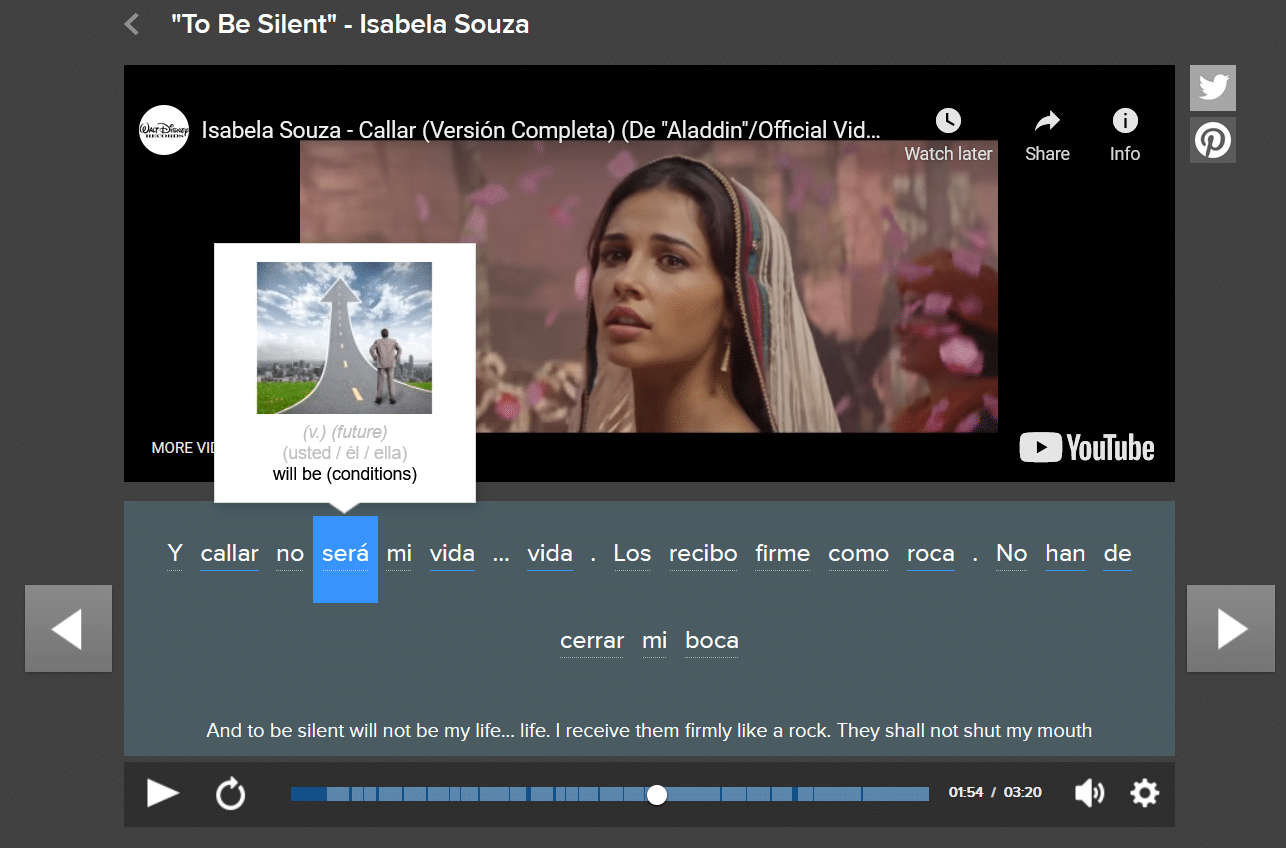
Regardless of your current skill level, I’ve got the tips you need to get you on the right track to Spanish fluency.
But can 14 simple tips really help you improve your Spanish that much? The short answer is yes!
If you stick with them daily and be consistent with your learning, you’ll soon be on your way to fluency.
Contents
Download:
This blog post is available as a convenient and portable PDF that you
can take anywhere.
Click here to get a copy. (Download)
1. Practice Spanish with Native Speakers
Practicing with native speakers is the best way to improve your Spanish!
For those who don’t live in a Spanish-speaking country, seek out Spanish speakers. Try using websites such as ConversationExchange and Facebook to connect with people in your local area.
Language exchanges are a fantastic way to socialize and improve not only your level of Spanish, but also your confidence when speaking it.
You can also use online resources and apps for language exchanges, such as Tandem and HelloTalk.
2. Keep Good Notes
The key to remembering vocabulary is to record it in a way that’s useful to you.
Even if you’re good at memorizing new vocabulary, it’s still a good idea to keep a written record for future reference. It’s also a great way to keep track of your progress.
Make a vocabulary diary, color-code your vocabulary or even make sets of flashcards. There are so many options.
The most important thing is that you find the way that works best for you.
3. Don’t Set Unrealistic Goals
Be realistic and make sure that you’ll be able to achieve your goals. The trick is to keep yourself motivated by meeting your targets.
A good way to do this is to set yourself achievable targets for fixed periods of time. This might be every two weeks, every month, whatever works for you.
Recording yourself speaking is another really good way to track your progress. Listening back to yourself in Spanish will help you notice any mistakes that you’ll be able to correct.
4. Write in Spanish
Writing in Spanish is a simple but effective way of instantly improving your language.
Any notes you make can be written in Spanish, such as your daily planner, grocery lists, recipes, reminders and anything else you put to paper (or digital device) during your daily life.
You could even start a diary in Spanish. Even if it’s just a few short, simple sentences a day, you’ll be able to see how your speed, fluency and word bank grow in the process.
5. Read in Spanish
Reading books in Spanish is a great way to have fun while improving your vocabulary.
If your Spanish is more advanced, you could start with some Latin American or Spanish novels, such as “Cien años de soledad” (One Hundred Years of Solitude) by Gabriel García Márquez or “Don Quijote de la Mancha” (Don Quixote) by Miguel de Cervantes.
If you’re a beginner, there are many options to help you start reading in Spanish and build up your level.
How about short stories or magazines in Spanish?
6. Listen to Music in Spanish
If you love listening to music, try adding some songs in Spanish to your playlist.
You could even print the lyrics or write them down and translate the song. Alternatively, you could pick out new vocabulary that you want to learn.
Learning the lyrics to Spanish songs and then singing along is a great way to improve your fluency. It’ll do wonders for your vocabulary, pronunciation and speed in Spanish.
Click here to see 30 songs to use to learn Spanish in 2023.
7. Incorporate Spanish into Your Daily Life
There are so many simple and fun ways to incorporate Spanish into your daily life.
If you enjoy watching movies, TV series or Netflix, try to watch them in Spanish.
You can either add Spanish subtitles to a movie you’re watching in English or even try watching the dubbed version in Spanish for an immersive experience.
Finding a high-quality video resource with accurate subtitles can go a long way. FluentU has dual-language subtitles. You can toggle the English translations off and just use the Spanish subtitles—or turn both off to focus on listening comprehension.

FluentU also allows you to check the meaning of any word at a glance or get more detailed information without even having to leave the video.
The program is available on your browser or by downloading the iOS or Android app, so you can learn wherever you are.
8. Make Language Learning Fun with Games
Do you love playing games on your phone or computer? Why not try out language games in Spanish?
Duolingo is all about gamified language learning. You earn points, work your way through levels and buy health potions for harder levels.
Memrise is a great app if you want to learn and practice new vocabulary. One of the best features is that you can create your own courses.
With different levels, games and activities, you’ll not only have fun but also improve your Spanish in the process.
9. Use Tongue Twisters to Practice Tricky Sounds
Tongue twisters are a great way to practice difficult Spanish sounds. Here are a few examples:
- To practice the Spanish r
Tres tristes tigres comen trigo en un trigal. (Three sad tigers eat wheat in a wheatfield.) - To practice the Castilian lisp
Son las cinco menos cinco, faltan cinco para las cinco, ¿cuántas veces dije cinco sin contar el último cinco? (It’s five minutes to five, five minutes left until five, how many times did I say five without counting the last five?) - To practice the g
De generación en generación las generaciones se degeneran con mayor generación. (From generation to generation the generations degenerate with greater degeneration.) - To practice the ñ
Del codo al caño, del caño al codo. (From the elbow to the spout, from the spout to the elbow.)
You can find more “trabalenguas” (tongue twisters) in this post.
10. Travel (or Move!) to Spain or Latin America
The best way to learn Spanish is to immerse yourself in the language.
But what is the best way to do this?
Travel to a country where everyone speaks Spanish! Not only will you get to speak in Spanish, but you’ll be reading, listening and even writing in Spanish nonstop. There’s nothing like going abroad and immersing yourself in the language to accelerate your language learning.
Why not immerse yourself completely by staying with a local family, or swapping all-inclusive hotels for Airbnb.
11. Volunteer Abroad
In exchange for a few hours of work during the week, volunteers are provided with accommodation, food and learning opportunities.
From working in a hostel to farming to working as a nanny, there are so many options!
Living in a Spanish-speaking country among native Spanish speakers will greatly improve your language abilities.
One of the best websites to find volunteering activities is Workaway.
Immersing yourself in the language, learning some new life skills, meeting friends and having a unique experience–the perfect way to improve your Spanish!
12. Volunteer Locally with Native Spanish Speakers
If you are interested in volunteering but you are not able to travel to a Spanish-speaking country, don’t worry, there are so many opportunities to volunteer in your local community and improve your Spanish at the same time!
Try looking on Google for different opportunities near you.
Be sure to pick an organization that’s staffed by Spanish speakers and/or works with the Spanish-speaking community so you can practice speaking with native speakers.
You could even host an exchange student from a Spanish-speaking country.
13. Don’t Take Grammar Too Seriously
The best way to improve your Spanish is to find comfortable, low-stress situations where you can practice with native speakers without worrying about grammar.
Prioritizing speed and fluency will help you get over the self-consciousness and doubts that impede many language learners. Your Spanish accent will improve–as will your confidence.
In most situations, speaking confidently and with good pronunciation will matter far more than whether or not you used the correct gender form of an adjective or if you mixed up the imperative and the subjunctive.
14. Learn Synonyms of Spanish Words You Already Know
The practical language you need to communicate may be a bit different from what you’ve learned from books or language classes.
Learn about the specific dialect you plan to use. This is particularly useful if you’re planning to travel to a particular country as each country will have their own dialects and varieties of Spanish.
Learn some slang, common phrases and expressions of that area. This is easy to achieve by talking to native speakers.
You can also use WordReference to find synonyms for the common words and phrases you already know.
With any of these tips, you’ll be able to take your Spanish to the next level!
Try them all to find out which one works best for you and have fun while improving your Spanish!
¡Buena suerte! (Good luck!)
Download:
This blog post is available as a convenient and portable PDF that you
can take anywhere.
Click here to get a copy. (Download)


![14 Effective Ways to Improve Your Spanish Skills [Updated for 2023]](/wp-content/uploads/2023/03/pexels-buro-millennial-three-people-sitting-on-the-stairs-talking-e1677084419952-768x513.jpg)
